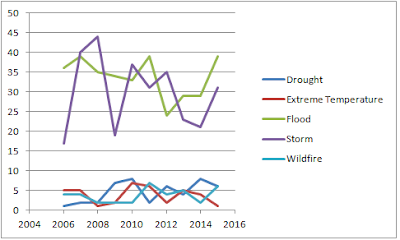Picking up from the previous post where I briefly profiled disasters in the Asia Pacific region for the past 10 years, this week I choose to shift my attention to the Americas. Last month, I highlighted a case of Louisiana flood that led to loss of 13 lives and destruction of properties and businesses, and just recently, the world witnessed as Haiti was hit by a major storm - Hurricane Mathew - causing a great deal of devastation. NASA termed the Hurricane as "the strongest storm to hit the Caribbean nation in more than 50 year". But this is just a fraction of the cumulative number of disasters that have occurred in the region, and their accompanying impacts on human and ecological systems.
 |
| Hurricane Mathew © NASA |
Overview
The World Bank estimates the population of the Americas at approximately 1 billion people . The countries in this region heavily rely on primary production and exploitation of natural resources for exports. The region boasts of an incredibly rich biodiversity despite continued loss of large forest cover with decreasing deforestation. Aide and colleagues argue that such contrasting dynamics present a level of uncertainty in terms of future alterations resulting from continued land use. Furthermore, such dynamics are highly linked to external factors like population trends and the demand for products (both for internal use and for exports). As a result of the existing pressures, large biomes like the Amazon forest, are significantly reducing in size. In assessing the "spatial patterns and statistical relationships between deforestation and changes in pasture and soybean areas", Barona et al. 2010 found a correlation between the high rate of deforestation and increasing pasture and soyabean grounds.
Extreme climate events
Data from EM DAT database indicates that a number of extreme events (drought, extreme temperature, flood, storms and wildfires) in the Americas have occurred in the past decade, although at varying frequency and level of intensity. Of the analysed events, floods and storms tend to occur more times in a years compared to drought, heatwaves and wildfire.
 |
| Frequency of extreme events in the Americas, 2006-2015 (Source of data: EM-DAT Database). |
Drought
|
Extreme temperature
|
Flood
|
Storm
|
Wildfire
| |
Occurrence
|
47
|
38
|
353
|
315
|
42
|
Total death
|
4
|
2,132
|
6,270
|
5,515
|
133
|
Injured
|
0
|
24,262
|
11,962
|
9,053
|
763
|
Homeless
|
0
|
5,247
|
445,506
|
282,246
|
33,901
|
Total Affected
|
47,398,840
|
1,611,939
|
40,753,477
|
105,78,466
|
902,680
|
Total damage(1,000 USD )
|
39,303,400
|
5,194,000
|
65,134,735
|
276,715,736
|
12,136,400
|
Losses and damages between 2006-2015 (Source of data: EM-DAT Database)
Floods have led to a majority of deaths in the past 10 years followed by storms and extreme events. As a result, an incredibly huge number of people were affected. Although droughts are seen to cause insignificant deaths in the region, the number of people affected tend to be higher compared to those affected by other disasters. More people are also affected by floods and storms. For the United States alone, the National Weather Services' statistics show that floods have caused higher fatalities on average compared to any other disasters.
 |
| © NOAA |
Conclusion
The frequency and intensity of extreme events in the Americas have been on the increase in the past decade with steep trends in areas where storms and floods are common phenomena. The scenario is likely to worsen in the face of climate change as global warming, coupled with the effect of El Nino Southern Oscillation, increases the risk of more severe weather. As a result, increased losses and damages are bound to be encountered, if adequate measures will not be put in place.
No comments:
Post a Comment